
The Fiat CR.32 was an Italian biplane fighter used in the Spanish Civil War and the Second World War. Designed by the aeronautical engineer Celestino Rosatelli, it was a compact, robust and highly manoeuvrable aircraft for its era, leading to it being a relatively popular fighter during the 1930s.

The Breda Ba.88 Lince ("Lynx") was a ground-attack aircraft used by the Italian Regia Aeronautica during World War II. Its streamlined design and retractable undercarriage were advanced for the time, and after its debut in 1937 the aircraft established several world speed records. However, when military equipment was installed on production examples, problems of instability developed and the aeroplane's general performance deteriorated. Eventually its operational career was cut short, and the remaining Ba.88 airframes were used as fixed installations on airfields to mislead enemy reconnaissance. It represented, perhaps, the most remarkable failure of any operational aircraft to see service in World War II.

The Breda Ba.65 was an Italian all-metal single-engine, low-wing monoplane used by Aviazione Legionaria during the Spanish Civil War and Regia Aeronautica in the first half of World War II. It was the only Italian ground-attack aircraft that saw active service in this role. It saw service almost exclusively in the North African and Middle-Eastern theatre. In addition to more than 150 aircraft operated by the Italian forces, a total of 55 were exported and used by the air forces of Iraq, Chile and Portugal.

The Breda Ba.64 was an Italian single-engine ground-attack aircraft used by the Regia Aeronautica during the 1930s.
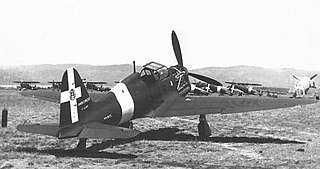
The Ambrosini SAI.207 was a light fighter interceptor built entirely from wood and developed in Italy during World War II. Powered by a single 750 hp Isotta Fraschini Delta, the SAI.207 enjoyed limited success during evaluation of the 12 pre-production aircraft.

The Aviatik B.I is a German two-seat reconnaissance biplane designed and built by the Automobil und Aviatik AG company, who until then had produced copies of French designs.

The Breda Ba.25 was an Italian two-seat biplane trainer designed and built by the Breda company. It was the most widely used Italian basic trainer of the 1930s.

The Fiat CR.1 was an Italian biplane fighter aircraft of the 1920s. Of wood-and-fabric construction, it was designed by Celestino Rosatelli, from whom it gained the 'CR' designation. Its most distinctive feature was that the lower wings were longer than the upper ones.
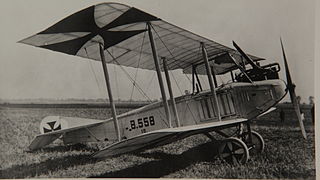
Note: Not to be confused with the Austro-Hungarian Aviatik B.II series 32, 32.7 and 34 which were different aircraft.

The Caproni Bergamaschi AP.1 was an Italian monoplane attack aircraft designed by Cesare Pallavicino, coming from the Breda firm.

The Breda A.4 was a biplane trainer produced in Italy in the mid-1920s. It was of conventional configuration with a two-bay unstaggered wing cellule and seating for the pilot and instructor in tandem open cockpits. Apart from civil use, the A.4 was also adopted by the Regia Aeronautica as a trainer. At least some examples were produced in floatplane configuration as the A.4idro.
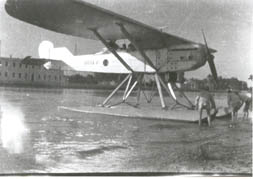
The Breda A.7 was a reconnaissance aircraft developed in Italy for use by the Regia Aeronautica in 1929. It was a braced parasol monoplane of conventional configuration with tailskid undercarriage. The pilot and observer sat in tandem, open cockpits. A single prototype of a long-range example, originally designated A.7 Raid and later A.16 was also constructed, but the air force showed no interest in it.

The Breda A.9 was a biplane trainer produced in Italy in 1928 for the Regia Aeronautica. Conventional in design, it featured a single-bay, unstaggered wing cellule and fixed tailskid undercarriage. The student and instructor sat in tandem, open cockpits. A slightly smaller version, designated A.9-bis was developed for use in Italy's aeroclubs.
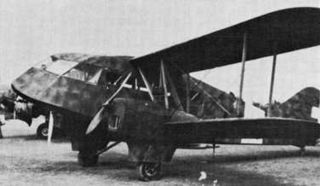
The Breda Ba.44 was a biplane airliner developed in Italy in the mid-1930s and which saw limited military service when impressed into the Regia Aeronautica as transports.

The Savoia-Marchetti SM.78 was an Italian bomber/reconnaissance biplane flying boat of the early 1930s.
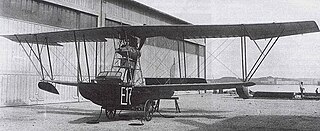
The Lohner E was a reconnaissance flying boat built in Austria-Hungary during World War I. The "E" stood for Igo Etrich, one of the Lohner engineers. It was a conventional design for its day with biplane wings that featured slight sweepback, and an engine mounted pusher-fashion in the interplane gap. Its crew of two was seated in an open cockpit.

The Macchi M.9 was a flying boat bomber designed by Alessandro Tonini and produced by Macchi in Italy close to the end of World War I and shortly afterwards.

The Caproni CH.1 was a single-seat biplane fighter, a single example of which was produced as a prototype in Italy in 1935.
The Piaggio P.10 was a 1930s Italian three-seat reconnaissance biplane floatplane produced by Piaggio.

The CANSA FC.20 was a twin engine reconnaissance bomber/ground attack monoplane designed and built in Italy in 1941. Several versions with different armament and engines were flown but only the FC.20bis ground attack variant reached squadron service, in very small numbers, before the 1943 armistice.





















